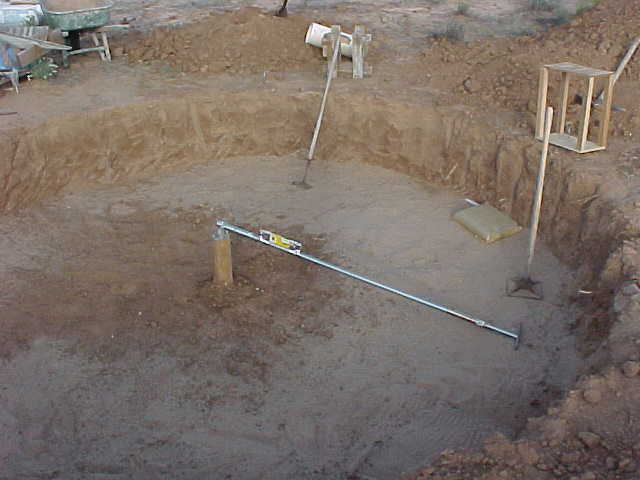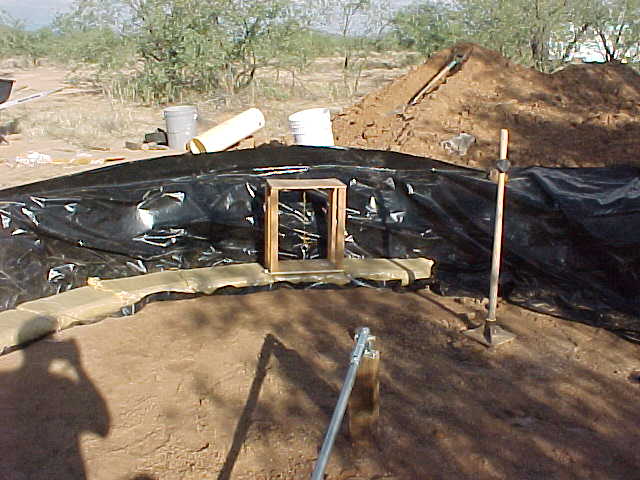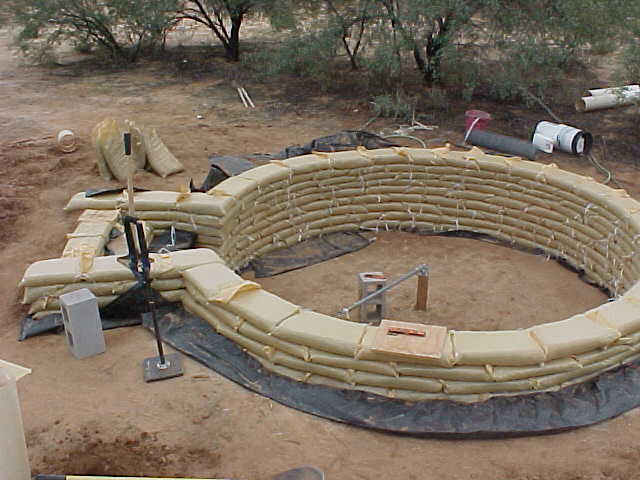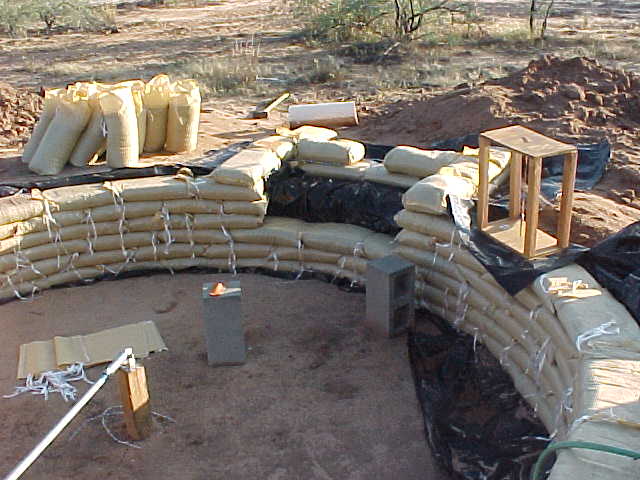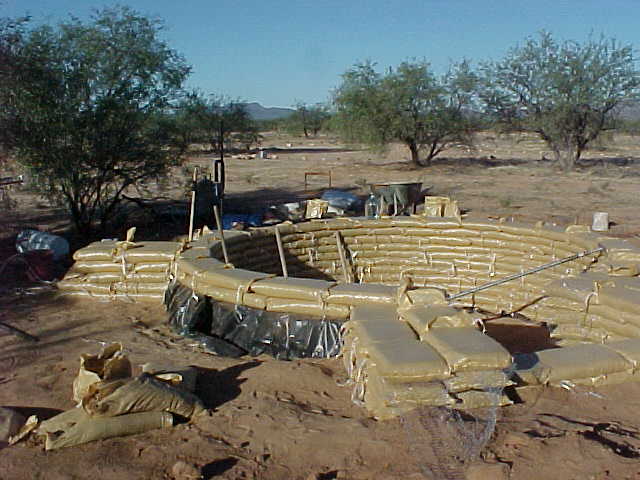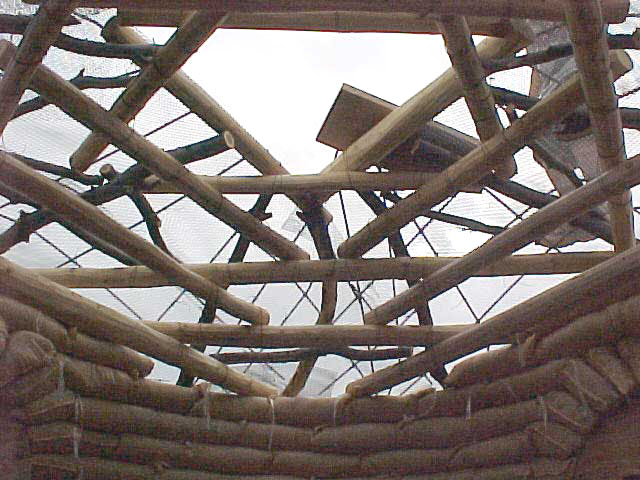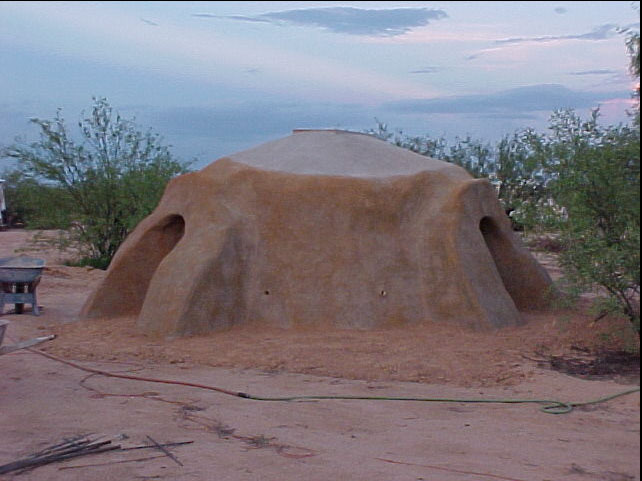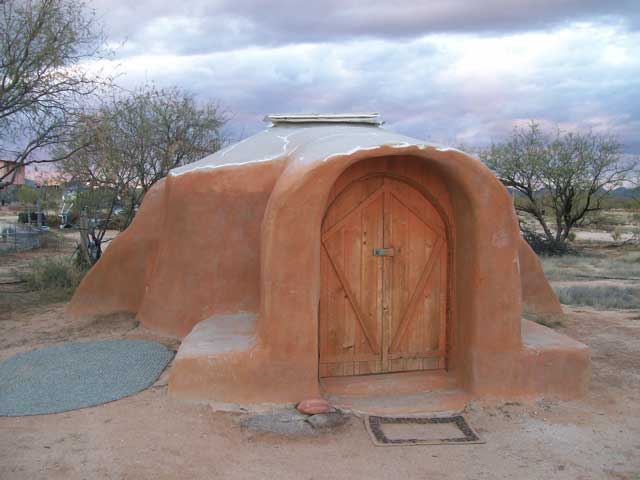| EarthDome House |
At Terrasante Village in the fall of 2000 our first experiment with earth was a simple, partially subterranian adobe-in-a-bag (aka earthbag) 12 foot circular structure with interior ferrocement retaining wall below grade. The structure has a slightly sloping flat roof, one door, one window, an opening skylight, as well as 4 inch PVC "vent" tubes in the walls, and a floor of sand from the local wash and cement. Material for the bag walls was excavated from the interior space and the walls were stuccoed with 1" chicken wire mesh for extra strength. The roof is built-up 4x8 beams on 2 foot centers, with a ½ inch plywood deck, roofing felt, mesh and stucco. The ceiling is insulated with 8 inches of fiberglass from severals sources.
Doors, windows, and cielings are made of recycled wood, metal, and glass. Most of the structure was created by two people (thank you Cory and Andreas) in about 6 weekends, with additional volunteers completing the stucco and "finish work over about two years. The space has a special energetic quality which is hard to describe, probably due to the circular nature, and earth. It is quiet and tends to be cool inside when it is hot outside, and vice versa.
The hybrid dome was inspired by our first experiment, the work done at Calearth, the creation of the 16 foot Honey-House of Doni and Kaki in Moab, Utah. Paulina Wojciowska's book Building with Earth, was used as a technical guide. Between the months of November 2003 and September 2004 we constructed a 12 foot diameter dome of earth and ferrocement. First we hired a tractor to excavate a 14 foot diameter circle to a depth of 3 feet. The mid-valley soil here is very hard when dry due to its clay content, it is mostly rock free, and lends itself to adobe and cob. Other than moisture, we added nothing to the earth..We created a template for a 12 foot quaternary arch on some old billboard panels stood up against a roof, tracing a 50 foot length of lightweight chain. It might be simpler to draw or trace an arch on paper, and scale the measurement up. One thousand UV stabilized polypropylene14 x 26 bags were ordered from Arizona Bag Co. in Phoenix at a cost of about $300 including site delivery of the 100lb. bale of bags.
A workshop was held on Nov. 2003, and the bags were placed on a water barrier of black plastic on earth about 3 feet down. We debated whether to create a masonry or rock foundation for the bag wall, and ultimately decided against doing so after reading of nearly indestructable walls during an earthbag demolition in Idaho. Bags were filled with "funnels" made from 8 inch PVC irrigation tubing, which kept the bags upright and open. Schedule 40 PVC or ABS would probably hold up to abuse longer. Bags were placed with the aid of a compass created from a 3 inch caster, and sections of 1" and ¾" telescoping steel electrical conduits with a set screw and wooden plate mounted at the end. A 4x4 post reference point was set at the center of the circle, and the compass was mounted apon it. We measured the curve of the billboard template and extended the compass as appropriate for the height above zero. Courses of bag were laid in a running bond, with 2 strings of 4 point barbed wire between courses. Soil was moistened prior to filling, enough to make it moist so as to form weak clods, but not so wet as to be mushy or sticky. After placement, bags were tamped using tampers. Our heavier (30lb) tamper was a 10"x12" piece of 1" steel mounted to a 2" steel pipe with an old shock absorbing bicycle fork for a handle. Our lighter tamper (10 lb ?) was purchased from a hardware store. Bags were filled with the needed amount of earth, and adjusted by adding or removing earth to maintain a running bond. Prior to filling, bottom end bag corners were "dippled ", ie. pushed in, to make a smoother wall surface. Lifting and then dropping the bags before placing settles the bags beginning the compaction process. The mouth of the bags were closed by folding the underside edge over the other, and then each bag was lifted and crammed with its folded open end against the butt of its neighbor, such that soil cannot spill out during tamping.
About 3-4 whacks with the heavier tamper produced the necessary compaction, which is also audible as the sound changes from a dull thud to a louder sharp whack! Bags were adjusted with the lighter tamper, flat ¾" boards, and levels. Proper course height was maintained within each course by measuring from the floor, and being sure the compass fell at the same spot on each laid bag. Occasionally it was necessary to redo too thin or thick laid bags by either adding or removing material. Maximum thickness of bags in a course could be achieved by laying a series of many bags butted tightly before tamping. When fully dry, the bags become rock hard. At about 1 1/2 ft above grade (4 1/2 foot of wall height), the plastic water barrier was folded around both sides of the wall and under a course of bags. We left the doorway area open creating steps down. We discovered that without a doorway form, the bags have a tendancy to creep inward with each succeeding course, and thus ended up creating a keyhole shaped doorway! Of scrap plywood and 2x4 we constructed wooden forms, 2 feet thick, for the arch doorway and windows. For the windows, this proved barely sufficient, and I would suggest making them thicker (3 feet), since the dome steps inward as bag courses are lain. Two forms, for an inner and outer vault doorway opening were created similarly. We discovered it is important to place lots of 2x4 supports along the sides and roof of the forms for strength, as tamped bags can expand, deforming a weak form.The window forms were about 3 feet tall, 3 feet wide and the door forms 3 and 4 feet wide. Forms were placed at120 and 240 degrees around the circle from the door, which faces east. Some 2" PVC pipe holes were built into the walls to allow passage of an extension cord later.
Buttresses to support the openings of the arches were laid on grade and integrated with running bonds into the walls. Buttress size was figured using about a 3:1 aspect ratio for height to extension outward from the dome, and from the arch center as well. We probably overdid the butresses, but too big is better than too small. We learned that butresses require lots of time and material to construct. We needed a dump truck load of extra earth for that reason! As the arches began to close, a piece of wire netting was placed first to wrap the bags and provide a mesh for stucco later. A key bag (or two) closed the arch, along with short pieces of barb wire for added grab.
As the wall approached a height of 6 feet, for reasons unknown, Calearth was unable to provide us with the plastic tubes necessary to close the dome. At this point we elected to change the design and create a double dome of ferrocement. Four inch diameter log vigas were placed in a triangular pattern apon the top layer of bags, and then cribbed up in about 4 successively smaller layers. This crib is ultimately decorative, since the ferrocement carries the roof load to the walls, but it did provide a framework for the steel. First we placed a layer of ¼ inch steel diamond lath sheets on the wood. A framework of ½" and 3/8" steel rebar on about 8" centers was placed on top of the mesh curving outward at the edge of the inside wall. An inner framework for the vault was similarly made. The mesh was then tied to the rebar at many places using 14 gauge baling wire. At this point, a triangular wooden frame for the skylight opening was created, and a secondary framework numbering about 12, 3/8" rebar loops each 10" wide built and tied to the existing steel to form the correct height for the outer dome and vault.
Next, a relatively thick stucco mix of 3- 4 parts sand 1 part masonry cement, and a bit of extra lime for stickiness was applied in 1/2 day to the inner dome with a team of 3 people. It would have been useful to have an extra person in opposition smoothing on the interior of the dome as the stucco was applied from the outside. We discovered that trying to go back and smooth it was impossible, only causing the stucco to fall through the mesh, so we left it alone. This left a rougher surface requiring more work later for the relatively difficult overhead plastering of the ceiling. We cured this dome layer over 72 hours with hourly soakings. A few days later the final dome was constructed with a 3/8" rebar frame, again on 8" centers. At this point we packed the space with recycled polystyrene chunks of various sizes. A mountain of this high R-value material is available for free in Tucson! Diamond mesh lath was next applied and tied to this frame, and down over the sides. There the mesh was pinned to the bags using 3" and 4" deck screws, #10 steel washers, and 2x2 "washers" made of diamond lath. In similar fashion the entire exterior was covered with 1" chicken wire netting, and pinned at many places to keep it tight to the bags. The outer dome and exterior was plastered with stucco of similar mix using various metal trowels. This rough coat was followed by two succeeding coats made of finer sands which were purchased, but which could have been sifted from the sand in our wash given more time. These last two coats were applied using rubber floats.
The interior was netted and plastered in similar fashion, with the final coats using white cement. Plastering the ceiling was a tedious, messy, and sometimes frustrating affair. Be sure to wear goggles, and expect to get plaster in your hair and face! The floor was made of portland cement and sand, the mix being about 1:6. The wooden door frame had been bolted through the wall prior to plastering, and the wooden window frames were similarly pinned to the bags with 6" lag screws. Square wood window frames were constructed of 2 x 3. The underside of arches were framed with strips of plywood, fitted, cut, and screwed and glued in layers. Windows were made of 1x2 and 1x3 screwed and glued, opening like doors inward. Glazings are of acrylic. A door was made of scraps of 1x6 tongue and groove panels. A triangular skylight was created of plywood and 1x2. An old casement window crank operates the skylight for venting. The outside was stained with a very diluted waterbase stain colored with iron oxide pigments and applied with a spayer. Earth was then piled up around the base to create an 18" berm around the perimeter for more thermal mass, and as a barrier to water in the event of flooding.
Shelving cut to fit the wall curves,was hung from the vigas. Despite its small size the space is airy and light. There is a calmness to the interior. The inside is relatively comfortable despite outside temperature fluctuations. Total cost of materials was about $1000, and we estimate about 75 person-days of labor, (many of those being manly-10 hr days). Many thanks to all who helped.
|
